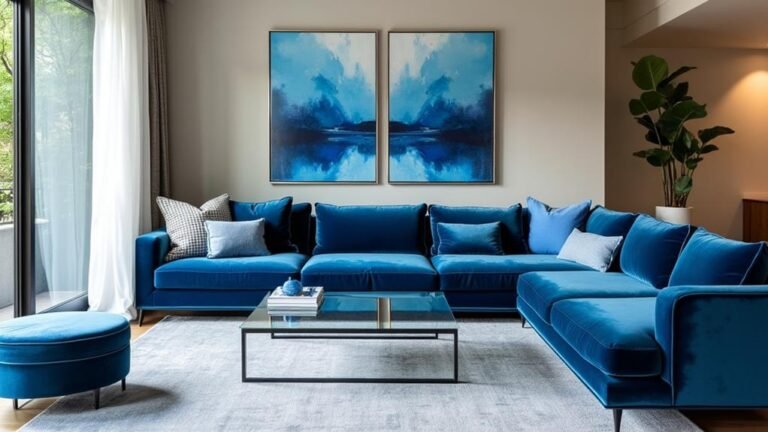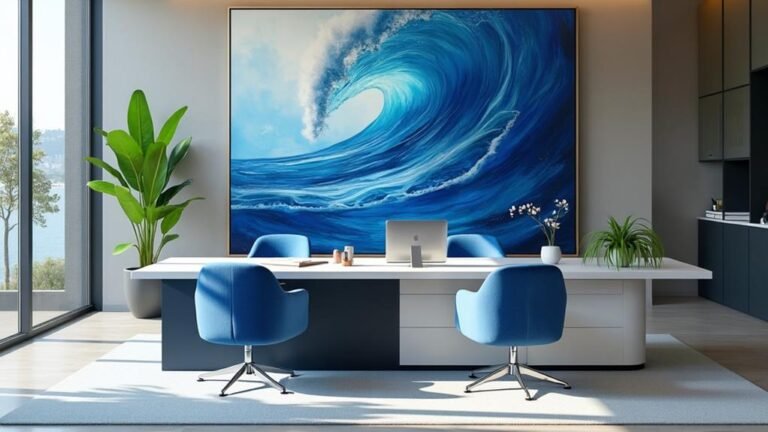Modern Interior Design: 7 Excellent Things You Didn’t Know About Using Indigo
Indigo isn’t just a fancy blue color – it’s got a lot more going for it in modern interior design. This deep shade brings class to any room, but there’s plenty you might not know about it.
From its roots in history to how it can affect your mood, indigo is a powerhouse in home decor. It’s super versatile, too, and can really change the look of your place. Plus, there are eco-friendly ways to use it that are worth checking out.
Want to know how to use indigo like a pro or pair it with other colors for a wow factor? Let’s dive into these cool facts and see what Indigo can do for your home.
Historical Roots of Indigo

Indigo’s history is deeply rooted in cultures worldwide. This dye, from the Indigofera plant, has been used for thousands of years, leaving its mark on many societies.
Ancient Uses
- Egyptians: Ancient Egyptians loved indigo’s bright color, using it to dye cloth and as body paint.
- Indians: Indian craftspeople became experts at indigo dyeing, creating detailed patterns that became a big part of their textile industry.
Trade and Economy
- Silk Road: Indigo was a prized item traded along the Silk Road, connecting Asia and Europe.
- Colonial Period: In the Americas, indigo became an important crop, especially in South Carolina, greatly affecting the southern colonies’ economy.
Cultural Significance
- Ceremonial Uses: Many cultures used indigo in rituals and ceremonies, seeing it as a symbol of protection and good fortune.
- Artistic Expression: From Japanese shibori to West African tie-dye, indigo’s versatility made it a popular choice for art.
Knowing indigo’s history helps you appreciate its role in modern interior design, showing how it has lasted through time and across cultures.
Psychological Effects of Indigo

Several studies have shown that blue, especially shades like indigo, can make people feel calm and relaxed. This makes indigo a great choice for different areas in your home, particularly places where you want to unwind, like bedrooms or cozy reading spots.
Benefits of Using Indigo
- Less Stress: Indigo can help lower stress levels. By using this color in your home, you might create a peaceful environment that helps you relax.
- Better Focus: The calming effect of indigo can help with concentration. This makes it a good choice for home offices or study areas, where you need to focus.
- Feeling More Balanced: The deeper shades of indigo can make you feel more stable and secure. Using this color in your living space might help you feel more emotionally balanced.
Practical Ways to Use Indigo
- Accent Walls: Try painting one wall indigo to make it stand out while keeping the room peaceful.
- Fabrics: Add indigo through pillows, blankets, or rugs to easily bring in the calming effect without making the whole room too dark.
Versatility in Color Schemes

Indigo is a super flexible color when it comes to decorating. You can use it as a main feature or just in the background, depending on what you want.
Complementary Colors
- Mix indigo with whites and grays for a classy, relaxed look.
- Want something bolder? Try pairing it with bright colors like coral or mustard yellow to liven things up.
Mood Creation
- Indigo can make rooms feel calm, so it’s great for bedrooms or places where you meditate.
- In areas where people hang out, like living rooms, use indigo with warm colors to make the space feel welcoming.
Accent Features
- Add indigo through accent walls, furniture, or decorations to make a room more interesting without going overboard.
- Use small touches of indigo, like throw pillows or art, to tie a room’s design together without messing up the balance.
This versatile color can really transform a space, whether you use a little or a lot. It’s all about finding the right balance for your style and the feeling you want to create in your home.
Indigo in Textiles and Fabrics

Adding indigo to your textiles and fabrics can really jazz up your home’s look. This deep blue color brings a sense of calm and class to any room. Let’s explore some ways you can use it.
Fabrics to Explore
- Cushions and Throws: Toss some indigo pillows on your neutral couch for a pop of color and comfort.
- Curtains: Indigo curtains not only keep the light out but also create a peaceful vibe in your space.
- Rugs: An indigo rug can tie your room together, especially when it matches other decor items.
Patterns and Textures
- Tie-Dye and Batik: Try out traditional techniques like tie-dye or batik to bring unique patterns into your home. These methods often have cultural significance too.
- Solid vs. Patterned: Mix solid indigo fabrics with patterned ones to keep things interesting but not overwhelming.
Maintenance Tips
- Colorfastness: Pick fabrics that won’t fade easily to keep your indigo looking fresh.
- Cleaning: Be gentle when cleaning indigo textiles to keep them looking vibrant.
Sustainable Sourcing Practices

Sustainable sourcing practices are becoming more important in modern interior design, especially when working with materials like indigo. Choosing indigo from eco-friendly farms supports farming methods that are better for the environment.
Here’s what to look for when sourcing sustainable indigo:
- Organic Certification: Pick indigo that’s certified organic. This means it’s grown without man-made pesticides or fertilizers.
- Local Sourcing: Try to buy from local suppliers. This cuts down on transportation and reduces carbon footprints.
- Fair Trade Practices: Work with producers who follow fair trade rules. This ensures workers get fair pay and have safe working conditions.
- Natural Dyeing Processes: Choose indigo textiles dyed using old-fashioned methods. These often use less water and fewer harmful chemicals.
Why sustainable practices are good:
- Environmental Protection: Using sustainably sourced indigo helps protect nature and keep different plant and animal species alive.
- Quality Assurance: Sustainable practices often lead to better quality materials that last longer and look nicer.
- Consumer Awareness: Supporting sustainable sourcing can make your brand look good to customers who care about the environment.
Using these sustainable practices in your design projects isn’t just about doing the right thing. It also makes your interiors look and feel better overall.
Complementary Color Pairings

Indigo is a deep, rich color that looks great with many other colors in modern home design. Let’s explore some color combinations that work well with indigo to make your space look even better.
1. Neutrals
- White: Makes indigo look deeper and creates a clean, fresh look.
- Gray: Balances indigo nicely, letting it stand out without being too much.
2. Earth Tones
- Terracotta: This warm, orangey-brown color works well with cool indigo, adding warmth to a room.
- Olive Green: A soft green that goes well with indigo, creating a calm, nature-inspired feel.
3. Bold Accents
- Coral: This bright, warm color really stands out against indigo, adding energy to the room.
- Mustard Yellow: A cheerful color that makes indigo-heavy designs more lively and fun.
Conclusion
Try out these color combinations to create a well-put-together and good-looking interior. By choosing the right colors to go with indigo, you can make sure it’s the main attraction while still fitting in with your overall design.
Incorporating Indigo in Small Spaces

Indigo can really spice up small spaces. It’s a versatile color that adds depth and style to cramped areas. Let’s look at some ways to use indigo in tight spots:
Accent Walls:
Paint one wall indigo to create a focal point. This trick can make a room feel bigger. Keep other walls light to balance things out.
Textiles:
Add indigo through pillows, rugs, or curtains. These items bring texture and warmth without overwhelming the space.
Furniture:
Pick indigo-upholstered pieces like a chair or ottoman. This subtly introduces the color while keeping the room cohesive.
Artwork:
Hang indigo-themed art or photos. This adds visual interest and ties different design elements together.
Accessories:
Use small indigo items like vases or picture frames. These accents are easy to swap out, giving you design flexibility.
Conclusion
Indigo can really jazz up your home design. It’s not just about looking good, though – this color can actually make you feel better too. Knowing where indigo comes from and how it affects people can help you use it wisely. You can mix and match indigo with other colors and fabrics to create a space that feels just right. Whether you go big with indigo walls or keep it subtle with a few accent pieces, this deep blue can totally change the vibe of your room. It’s not just about making things pretty – it’s about creating a space that shows you’ve put real thought into your design.






